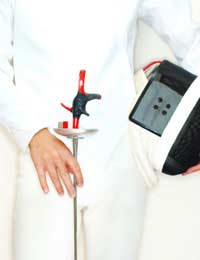Staying Safe When Fencing

Crossing swords with an opponent is one of the oldest forms of competition, requiring speed, agility and no little amount of bravery. It is also a very physical game of chess, testing the mettle of the other competitor, and building a strategy upon which the coup de grace can be delivered.
However, in common with all sporting contests, there is an ever-present risk of injury, which is why there is a strict code of practice in force to ensure that a bruised ego is the most that the loser is left nursing.
Safety starts with the referee of the contest, who must not only ensure that all the equipment is up to standard but also that in the heat of the battle, both sides remember that this is purely a friendly encounter. This is not to say that each fencer should not be enthusiastic in their approach, but the aggression must be controlled – loss of temper not only places a competitor at risk of losing focus and losing the match, but they may end up doing damage to themselves or their opponent.
Jackets and breeches must be correctly fitted
Safety checks should begin with the clothing of each fencer: jackets and breeches must be correctly fitted and without any tears, and the latter should be long enough to cover the top of the socks. Underneath the jacket, a quilted pad known as a plastron is also required, in order to protect the chest, waist and sides. Female contestants must also wear breast protectors. The gauntlets must extend over the sleeves of the jacket and up to around half the length of the forearm.
Because of the cut and thrust of the battle, it is essential that the fencer’s footwear has a good grip, in order to prevent any slips that could result in injury.
Another important area is the head, which is protected by the most visible piece of safety equipment in the fencer’s locker: the mask. Suitable headgear must conform to a manufacturer’s safety standard, and the mesh that covers the face must be checked in order to ensure that there are no tears.Check to ensure the blade is not damaged
In terms of the weapon itself, it is always subject to a rigorous check to ensure that the blade is not damaged, as this is the most common reason why injuries occur. The guard of the weapon is another area that should be scrutinised as any sharp edges can lead to injuries to an opponent’s lower body during the contest.
Young children are often taught the basics using foam weapons but even these relatively safe implements come with a requirement to wear a plastic facemask.
Ultimately, safety is all about commonsense, as the above guidelines illustrate. As long as every competitor has a respect for these rules, along with an equal respect for their opponent, then there is no reason why a fencing contest cannot be conducted without the risk of injury. Everyone wants a good, clean, competitive battle that lives up to the traditions of this historic sport.
Each fencer has a responsibility to uphold these traditions.
Business Energy With a Difference
If you are looking for business energy or need advanced solutions like remote energy monitoring, new supplies, downgrading or upgrading capacity, have a no obligation chat with Purely Energy.
To find our more get in touch here. or call 0161 521 3400.








